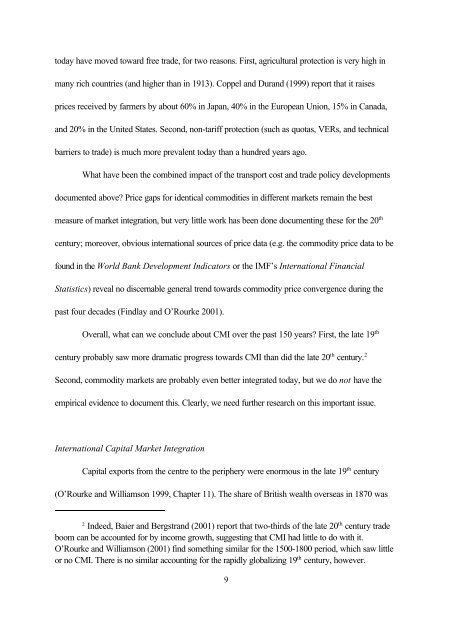Globalization and Inequality - Trinity College Dublin
Globalization and Inequality - Trinity College Dublin
Globalization and Inequality - Trinity College Dublin
You also want an ePaper? Increase the reach of your titles
YUMPU automatically turns print PDFs into web optimized ePapers that Google loves.
today have moved toward free trade, for two reasons. First, agricultural protection is very high in<br />
many rich countries (<strong>and</strong> higher than in 1913). Coppel <strong>and</strong> Dur<strong>and</strong> (1999) report that it raises<br />
prices received by farmers by about 60% in Japan, 40% in the European Union, 15% in Canada,<br />
<strong>and</strong> 20% in the United States. Second, non-tariff protection (such as quotas, VERs, <strong>and</strong> technical<br />
barriers to trade) is much more prevalent today than a hundred years ago.<br />
What have been the combined impact of the transport cost <strong>and</strong> trade policy developments<br />
documented above? Price gaps for identical commodities in different markets remain the best<br />
measure of market integration, but very little work has been done documenting these for the 20 th<br />
century; moreover, obvious international sources of price data (e.g. the commodity price data to be<br />
found in the World Bank Development Indicators or the IMF’s International Financial<br />
Statistics) reveal no discernable general trend towards commodity price convergence during the<br />
past four decades (Findlay <strong>and</strong> O’Rourke 2001).<br />
Overall, what can we conclude about CMI over the past 150 years? First, the late 19 th<br />
century probably saw more dramatic progress towards CMI than did the late 20 th century. 2<br />
Second, commodity markets are probably even better integrated today, but we do not have the<br />
empirical evidence to document this. Clearly, we need further research on this important issue.<br />
International Capital Market Integration<br />
Capital exports from the centre to the periphery were enormous in the late 19 th century<br />
(O’Rourke <strong>and</strong> Williamson 1999, Chapter 11). The share of British wealth overseas in 1870 was<br />
2<br />
Indeed, Baier <strong>and</strong> Bergstr<strong>and</strong> (2001) report that two-thirds of the late 20 th century trade<br />
boom can be accounted for by income growth, suggesting that CMI had little to do with it.<br />
O’Rourke <strong>and</strong> Williamson (2001) find something similar for the 1500-1800 period, which saw little<br />
or no CMI. There is no similar accounting for the rapidly globalizing 19 th century, however.<br />
9
















